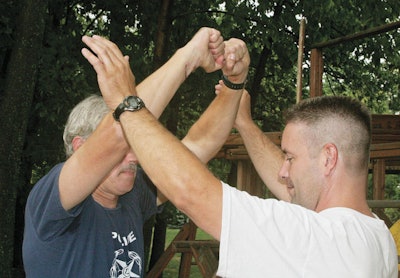 Photo courtesy of Tom Wetzel.
Photo courtesy of Tom Wetzel.
There are plenty of things that a suspect should not have his or her hands on. An officer's handgun and the steering wheel of a cruiser are two that could cause some serious stress to anyone wearing a uniform. Having a suspect's hands on your neck or throat is another that can put your life in immediate jeopardy. Getting those hands quickly off your neck is a priority. Being prepared with some basic defenses could save your life if confronted with this type of assault.
The threat to an officer from a choke is very serious. Depending on where a suspect's hands are on your throat, you may be unable to breathe or the blood flow to your brain may be stopped. It is a target of choice for inflicting serious harm. If a suspect is trying to choke you, you are in a deadly force encounter and accessing your handgun would be appropriate. But depending on what direction the bad guy assaults you from and the accuracy of your shot placement, your gun may not always provide the best immediate option.
Separate, Stun, Strike Principle
A good defense against a choke option can involve a separate, stun, and strike approach. Whether an assault takes place at the front, side, or rear location against you, the first goal is to get the suspect's hand or hands separated from your throat or neck. The next step is a quick stunning action to a part of the suspect’s body to disorient him, followed by a power strike to the suspect's head area.
This combination of self-defense actions that can include a variety of different techniques can help you defend yourself from a violent attack to your neck or throat. The following addresses separate, stun, and strike responses for choke assaults to your front, side, and back.
Front Choke
When a bad guy facing you puts two hands on your throat, the first step is to get his hands separated from you. With a slight inward step to the side, conduct a quick aggressive diamond block. This involves taking both hands in closed fists and striking in an upward motion against the suspect's hands at his wrists to separate them from your neck.
From there, deliver a downward double shuto strike (open-hand strike using the outside portion of your hand for the contact point) to the sides of the suspect's neck, which can cause a painful stunning effect. From here, bring both hands back to yourself and then deliver a double tiger's mouth strike (forward strike where hand is open at the thumb and index finger and contact made with inside area of hand) to the throat of the suspect.
Side Choke
If a suspect grabs you with two hands on the side the neck, the first part of the technique is to step out with your outside foot and then take your inside hand and knock off the suspect's front hand, which would be the dangerous one on the front of your throat. Again, the point of contact should be against the suspect's wrist.
From here, drop your same striking hand into a back fist strike to the groin area. This strike could have a stun effect, particularly on male suspects. Follow this up by reversing course upward with a back fist strike to the face.
Back Choke
If a suspect grabs your neck from behind with two hands, first take a rear side step while taking your arm on that same same side and sweeping it up and wrapping it around both of the suspect's arms at the elbow. Then use your other arm to punch the suspect's rib area, which should now be exposed. This should be followed with a strike to the head.
Follow-up Action
When practicing these techniques, also work to incorporate getting distance from the suspect or taking him to the ground and handcuffing him, depending on the suspect's condition. Other techniques taught by your defensive tactics instructor may involve these actions.
Handgun Defenses
Don't completely dismiss your duty weapon as defense against a choke. In addition to working on these self-defense techniques, you should also practice drawing your weapon while a suspect is choking you. Then practice pulling the trigger on your empty handgun for front and side chokes.
Also be aware that these close-quarter conditions may result in a struggle for your handgun, if the suspect transitions to grab your weapon. Any DT instructors teaching officers to escape chokes should incorporate these tactics and information into the training.
Preparation and Practice
An officer has a higher likelihood of getting physically assaulted than getting shot at. That's why you should be prepared to defend yourself against attacks to your throat, a vulnerable area usually visibly exposed to suspects. Practice getting an assailant's hands off your neck and stunning and striking him while standing as part of your training regimen. Should someone ever try to choke you on duty, you'll know exactly what to do.
Tom Wetzel is a northeast Ohio suburban police lieutenant, SWAT officer, trainer, and certified law enforcement executive.











